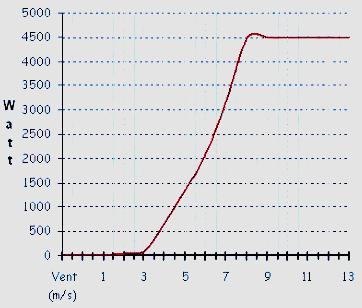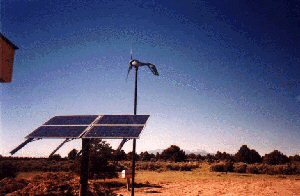Wind energy and its challenges.

wind farm superpower
1) What is wind power?
It is renewable energy "in fashion" but not necessarily the most efficient.
The blades of wind turbines capture the mechanical energy of the wind. You can choose to use it directly or transform it into electrical energy.
1.1) Mechanical energy
It is used directly for example for pumping, to raise water from a water table. These are the "Western" wind turbines.
1.2) Electric energy
We are talking about a wind generator, talking about a wind turbine is an abuse of language that we will also do!
Mechanical energy is converted into electrical energy by a generator then sent to a transformer which will bring it up to the standards of the electrical network.
The electricity produced can be fed into the grid in whole, in part or not at all. In the latter two cases, electricity will be directed to sites that have chosen wind power as a backup source, or sites not connected to the grid that depend entirely on their wind turbine or other renewable energy sources.
Electricity can be used in continuous flow but it can also be stored in batteries. The continuous flow is more profitable and above all more technologically affordable. Batteries are overpriced and are an unimaginable solution beyond a certain wind power.
The main disadvantage of this renewable energy source is its lack of flexibility.The wind may not blow when it is needed. The purchase by EDF is then the only possible solution.
There are other batteries that storage methods (see document how to store energy?) But they are still difficult to implement.
For smaller sites, batteries then take over if the wind turbine is stopped, but their efficiency is very limited. We will not discuss the environmental problems associated with the use of batteries in large quantities.

Power curve characteristic of a small wind turbine
2) Issues
2.1) What benefits?
Two big advantages: it is clean and renewable energy. During its operation, it does not cause any release (no greenhouse effect or acid rain) and no waste (toxic or radioactive). As for the energy expended for the manufacture and installation of the wind turbine, it would be "caught up" after about six months of operation. Some other sources claim that a wind turbine will never offset their CO2 cost from their construction.
During the life of the wind turbine the land is always usable, for agriculture for example. Then the installation can be dismantled quickly and leave the premises in their original state.
Small installations make it possible to electrify isolated places and give a certain independence to small communities (a village, a group of industries, etc.)
2.2) And the disadvantages?
Rather than disadvantages, it is appropriate to speak of constraints. They relate to large wind turbines.
2.2.1) Energy and Power
The main drawback is the lack of flexibility of this renewable energy (as is the case with most renewables). We don't need energy only when it's windy! The fact of selling energy by a large supplier (EDF or other) makes it possible financially (but not ecologically) to compensate for this major drawback. It is generally accepted that a wind turbine operates at its nominal power 1/5 of the time in a year. So should be divided by 5 installed capacity for the actual average power, therefore the energy supplied by the installation.
It should be noted that Denmark, a European model for wind power, has one of the electric kWh which emits the most CO2 because, in the absence of wind, the relay is taken by small and medium-sized generators which are very "polluting" .
In addition to the absence of wind, the power of the wind turbines is limited by the low mass of the air: the recoverable power per m² is not high. Thus, a wind farm considered of great power, say of 20 MW, represents barely 1/50 of the power of a nuclear reactor and therefore 1% of the power of a plant 2 with nuclear reactors. More: Wind power and nuclear power comparison.
This lack of power is a major drawback of wind power compared to nuclear power, for example. But it has the invaluable advantage of being renewable and of not leaving ecological bills for future generations. But in the best of cases, wind power in France in 2010 will at best compensate for the increase in our energy consumption.
2.2.2) The initial cost
The cost of study, manufacture and installation is, in our opinion, too high. As a result, most wind farms do not pay off, all costs combined, until a few years before the wind turbines end of life. We are talking about 15 years of return on investment over the 20 years of life of a wind turbine announced. These facts are unfortunately systematically observed on renewable energy projects (See the file: “Why is it stuck?”) And this whatever the technology used ...
2.2.3) Gigantism
In electric wind power, there is an undeniable fact: the fact of wanting to create increasingly large wind farms, with more installed and unitary power.
Thus wind turbines of 5 MegaWatts, 100 m high and 60 m in rotor diameter are emerging. If these projects are remarkable technological challenges (design, resistance of materials…), we can ask ourselves the question of econological efficiency. These projects are obviously not financially accessible to individuals or small businesses. Most companies in this field are content to do the economic feasibility study to resell it to a client with the means of investment. In addition, some do not hesitate to engage in land speculation in this area, which can block projects for years.
Wind power therefore seems to be reserved for large companies that already have an energy monopoly, whereas the solution would rather be micro-wind power accessible to all, or even participatory associations (as in Denmark) for medium-power projects.
But there is even worse: we look at the montage for Bouin Park.
A few years ago, under pressure from the State, EDF made a commitment to buy wind power at a very good price, up to 7,5 cents per kWh. This purchase at a high price is possible thanks to public subsidies (ADEME and others) financed by large companies which are tapped from their energy consumption and to a lesser extent by our taxes and various taxes.
Without these subsidies, wind power (large power) is currently not profitable in France.
The financial package for EDF is simple: the Bouin wind farm has around 20 MW installed thanks to subsidies from ADEME and the Region and it is 70% operated by SIIF which is nothing more than a subsidiary of 'EDF.
EDF therefore buys overcharged but largely subsidized electricity. Obviously, the general public receives the classic discourse of sustainable development without knowing that it is they who largely pay for this sustainable development by increasing their bill (remember nuclear electricity).
A system where the consumer would pay in full transparency and knowing the real price for wind power would be much more sustainable ... without financial shenanigans as is currently the case.
We're betting that wind turbines would disappear quickly if subsidies were cut! Where is the logic in that econological?
Please note this speech is only valid for France where the price of nuclear kWh defies all competition!
2.2.4) Visual impact
Many associations or individuals are against the establishment of wind turbines near their homes. The argument is simple and constant but rarely justified: “It's ugly, it makes noise! Leave us alone! ".
It is noted that one of the biggest anti-wind association (ventdecolère) is held by EdF retirees, this is certainly no coincidence!
But where does this movement of associations (often ecological) come from when no one has ever said anything against: 1) high voltage lines much uglier and, moreover, electromagnetic pollution is much more harmful 2) the visual impact of large factories or nuclear power plants whose cooling towers can be seen miles away… etc etc. The question deserves to be asked!
2.2.5) Wildlife
It is true that the speed of rotation of the blades at their end may surprise some birds (see the example of the Bouin wind farm). Wind turbines should be avoided on migration corridors. In comparison road traffic, windows (home) and power lines kill in Denmark, a country saturated with wind turbines, 200 times more birds per year. (20 versus 000)
2.2.6) Noise
The noise of the wind on the blades is audible and above all it is permanent. The movement of the gondola which blows into the wind is much noisier but it remains exceptional: at 500m, the noise is only 25-30dBA, which is the noise of an office environment. It is prudent to leave this distance between the wind turbines and the nearest dwellings.

A small wind power for individuals
3) Costs
The most important argument of the opponents is that the cost of wind kWh is higher than that supplied by traditional power stations: they do not take into account in their calculations ecological costs which are excluded from production costs because they are not at the responsibility of the producers (or resellers). On the other hand, with regard to France, our country has accumulated such a delay in renewable energies that successive governments have imposed on EDF a buyback policy at a high price to encourage investment. A price increase that EDF is quick to pass on to the bill of end consumers, individuals or businesses. This phenomenon contributes to the reputation of “too expensive” wind power. This applies to large wind farms but also to small individual installations experience similar problems. The facilities are marketed at such high prices that they cannot be profitable in the current context except for isolated sites (but in this case it is a marginal development)
Yet nothing justifies such high tariffs ... except the converging interests of EDF which does not want to escape from a clientele that would produce its own electricity, from the State which is keen to safeguard the taxes it earns from the centralized sale of electricity and from manufacturers who over-charge their products.
Conclusion
Wind turbines are one of the cleanest sources of energy and the inconveniences they can present are easily avoided if they are the subject of precise and intelligent management. The cost problems are largely artificial, the result of political and financial choices more than of the wind principle itself. As an example, we recall that wind power supplied 30% of industrial installations in the Ruhr just before World War II.
Wind turbines may not be the ideal solution (but none are) but their reversibility makes them champions of sustainable development. In general, it is the association of several renewable energy techniques which constitutes a better solution. So solar and wind are complementary because, generally, the sun shines when the wind is not blowing.
The problems of overcharging by professionals can be compensated by assembling a small wind turbine yourself, but this is reserved for good DIY enthusiasts. For this a reference site: Mini Aeolian

Solar-Wind Energy Association in a particular
Learn more
- Forum wind, wind turbines and renewable energies
- For or against the wind? Debate!
- wind power against nuclear: an unequal battle
- Cost and price of electricity
- Forum technical and economical

